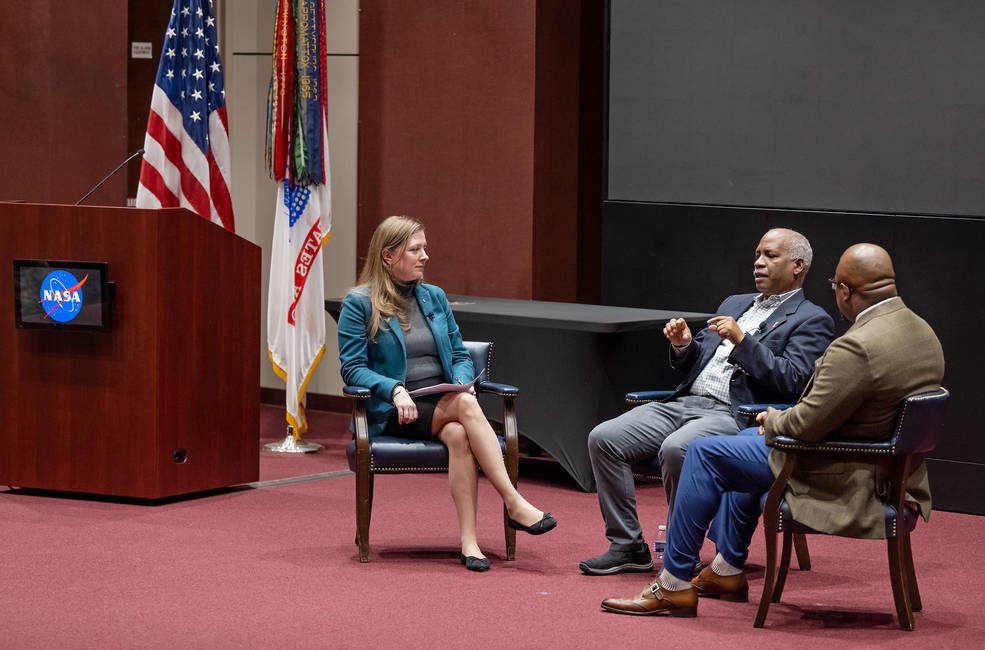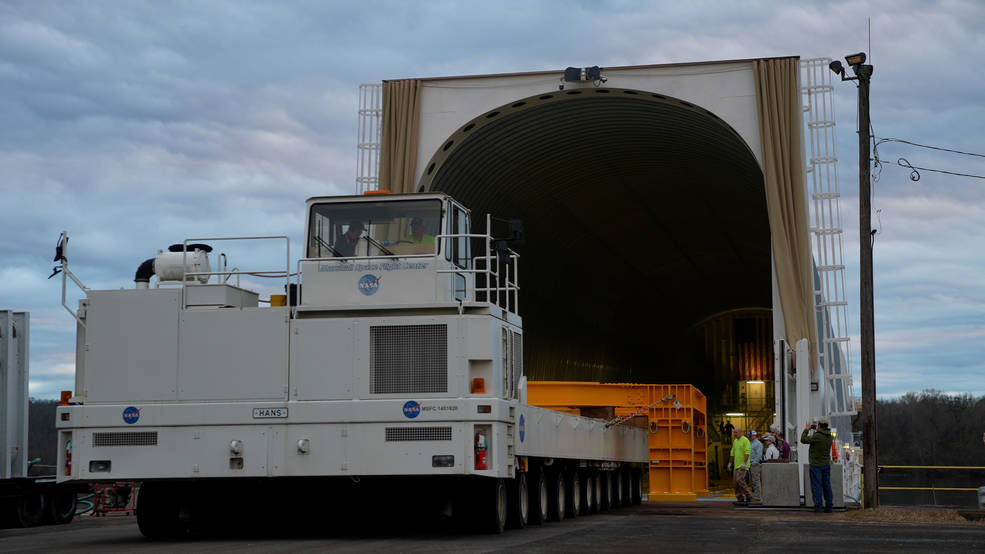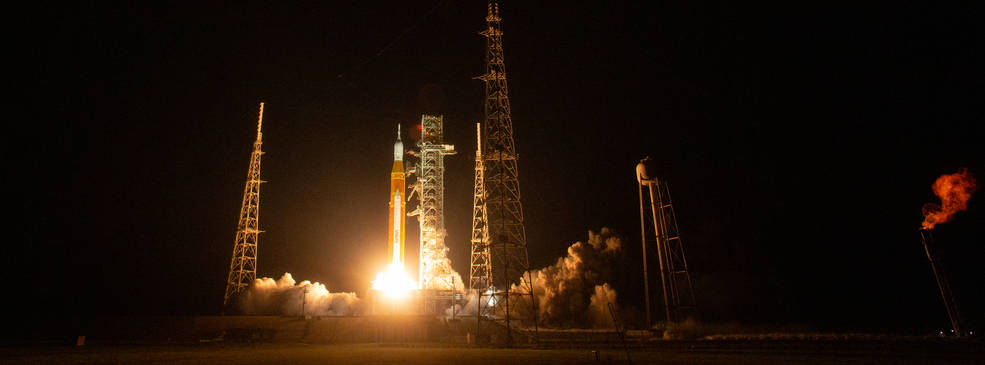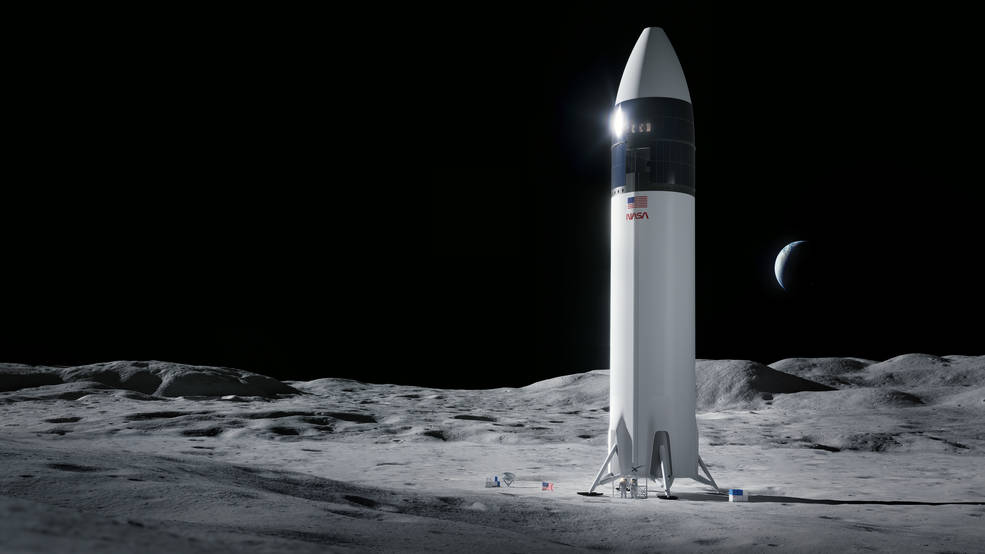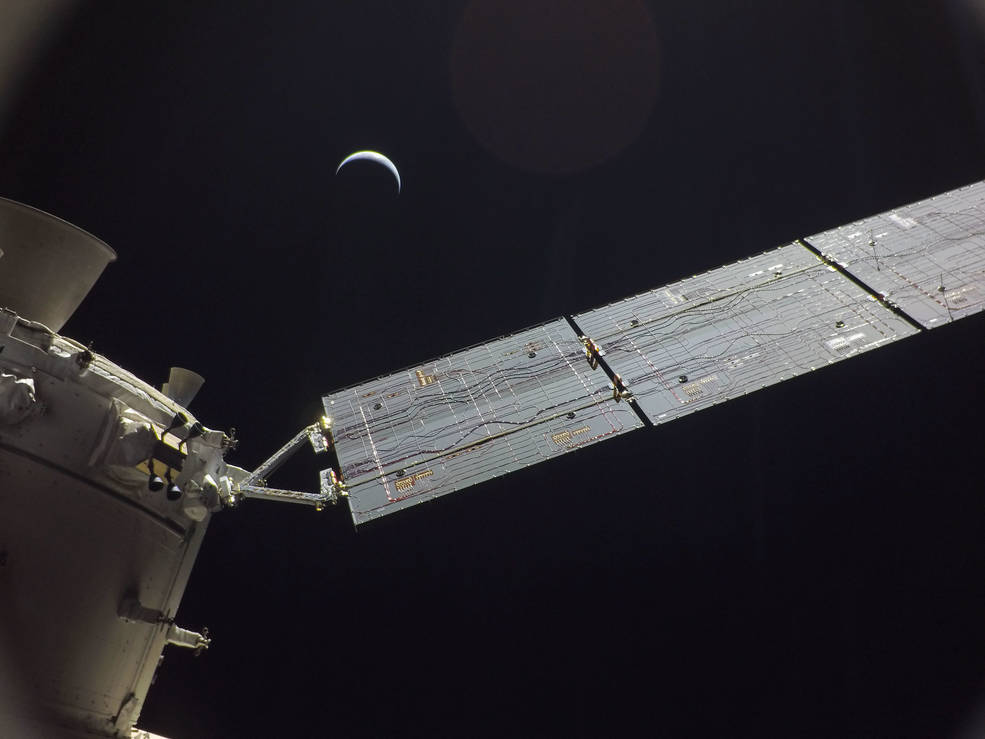The Marshall Star for January 18, 2023.
In This Week’s Star
- MLK Day Observance Highlights Importance of Community Service
- NASA Barge Delivers Transportation Stand to Support Crewed Artemis Mission
- IXPE Mission Team Profile: The Laboratory for Atmospheric and Space Physics
- Astronomers Dig Out Buried Black Holes with NASA’s Chandra
- Webb Uncovers Star Formation in Cluster’s Dusty Ribbons
- Lunar Flashlight Team Assessing Spacecraft’s Propulsion System
- Artemis III: NASA’s First Human Mission to the Lunar South Pole
- 50 States: Small Businesses
MLK Day Observance Highlights Importance of Community Service
NASA’s Marshall Space Flight Center, along with the U.S. Army and FBI, hosted a Martin Luther King Jr. Day Observance on Jan. 9 at Bob Jones Auditorium. The theme of the observance was “A Day On, Not a Day Off.” Seated at left, Marshall Deputy Manager of Science and Technology Office Dayna Ise moderates a panel featuring the event’s two keynote speakers. Seated at center, Huntsville City Council President John Meredith discusses the significance of honoring King’s legacy with community service while fellow keynote speaker and pastor of First Missionary Baptist Church in Huntsville Don Darius Butler listens in. Marshall Associate Director, Technical Larry Leopard also addressed the audience, encouraging attendees to give their time to invest in the next generation of diverse leaders in their workplaces and schools. “Dr. King knew that a successful education lays the foundation of a great society,” Leopard said. “And that is work that NASA and Marshall Space Flight Center strive to accomplish every day.” (Credits: NASA/Charles Beason)
Huntsville City Council President John Meredith, left, and First Missionary Baptist Church Pastor Don Darius Butler stand with their 2023 Martin Luther King Jr. Day Observance plaques of appreciation. The two men served as keynote speakers for the Team Redstone MLK Day Observance on Jan. 9 at Bob Jones Auditorium. Deputy Director of Marshall’s Office of Diversity & Equal Opportunity Carolyn Magsby presented the plaques and thanked Meredith, Butler, and all who helped organize the event. (Credits: NASA/Charles Beason)
NASA Barge Delivers Transportation Stand to Support Crewed Artemis Mission
Crews from NASA’s Marshall Space Flight Center offload a transportation stand from NASA’s Pegasus barge Jan. 7. The barge ferried the stand from NASA’s Kennedy Space Center, where it was used to transport the launch vehicle stage adapter (LVSA) of the Space Launch System (SLS) rocket for Artemis I. The nearly 28-foot-tall LVSA is a cone-shaped element that connects the rocket’s core stage and the interim cryogenic propulsion stage (ICPS) and partially covers the in-space stage’s single RL10 engine. It is fully produced and manufactured at Marshall by Teledyne Brown Engineering, the LVSA lead contractor. The transportation stand is one of two at Marshall and will be used as teams continue to manufacture the LVSA for Artemis III. NASA and Teledyne Brown Engineering use the stands to maneuver the LVSA hardware from facility to facility, across the facility, and for application of the thermal protection system. After unloading the transportation stand from Pegasus, teams at Marshall will load the Artemis III LVSA hardware onto the stand to transport it to the facility where the thermal protection system spray foam will be applied by hand. (NASA/Sam Lott)
IXPE Mission Team Profile: The Laboratory for Atmospheric and Space Physics
By Rick Smith
As NASA’s Imaging X-ray Polarimetry Explorer mission explores black holes, neutron stars, and other cosmic phenomena – helping to answer fundamental questions about extreme space environments – it relies on the mission operations team at the Laboratory for Atmospheric and Space Physics, or LASP.
Some 700 people – engineers, scientists, mission-operations personnel and data specialists – staff the Laboratory for Atmospheric and Space Physics, housed on the campus of the University of Colorado-Boulder.
For the IXPE mission, LASP flight controllers and support teams monitor and maintain all command and control functions for the spacecraft, as well as planning and scheduling, data integrity, and spacecraft health and safety.
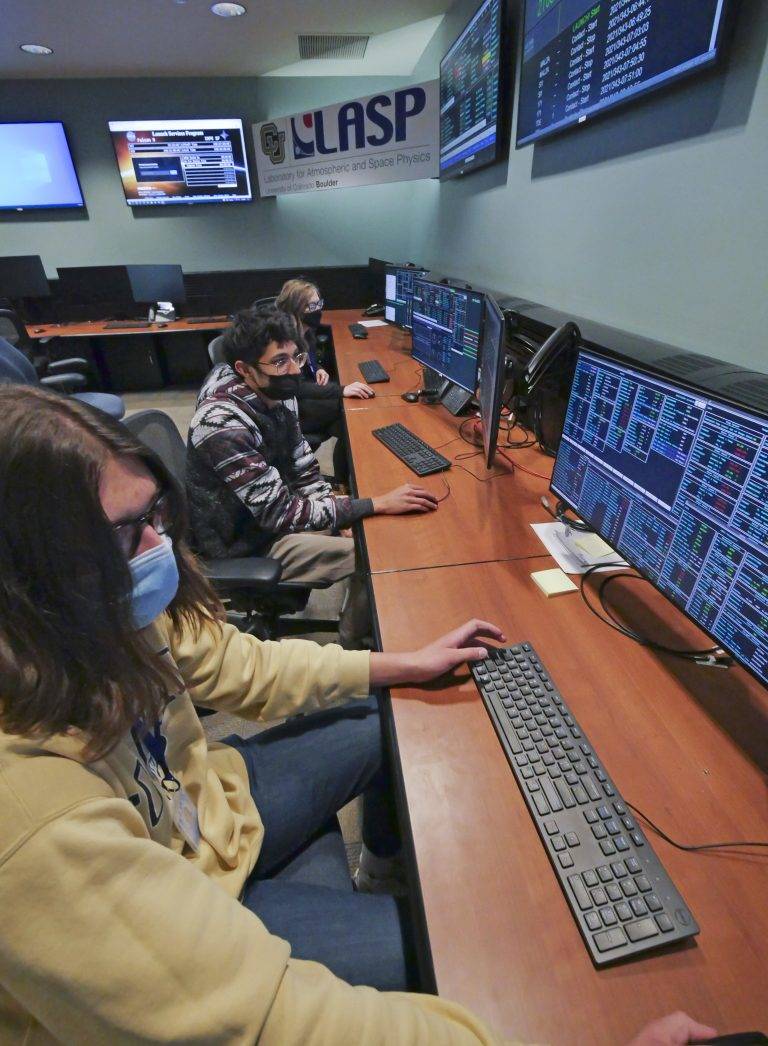
“I get very excited about IXPE science results,” said LASP flight controller Kacie Davis. “IXPE is unique and groundbreaking because it measures polarized X-ray imagery – tracing light back to its source by precisely measuring its brightness and the direction in which photons flow from the source.”
Research leads in the IXPE Science Operations Center at NASA’s Marshall Space Flight Center identify targets and instruct LASP flight controllers to point at them for specific intervals, fine-tune calibrations, and collect the resulting data. All raw-data findings are processed and delivered to the primary IXPE science team within seven days of each completed observation.
Most of the cosmic objects IXPE observes are part of a carefully managed, year-long science operations plan, but the LASP team also may get alerted to reposition the spacecraft to observe unique targets of opportunity, known as “TOOs” in mission-ops vernacular. Such phenomena – a new supernova, perhaps, or an overstuffed black hole trying to digest a neutron star – are rare, but the LASP team is quick to respond, at any hour.
“It’s a lot of work and a quick turnaround, like having a child,” said researcher Stephanie Ruswick, who in late 2022 will succeed LASP’s current flight director, Darren Osborne. “The other night, my 1-year-old slept through the night… but IXPE did not! Our team is always ready to step up and meet those unanticipated requests.”
The LASP team includes a cadre of CU-Boulder undergraduates, Osborne said – a big advantage for career-minded engineering and science students.
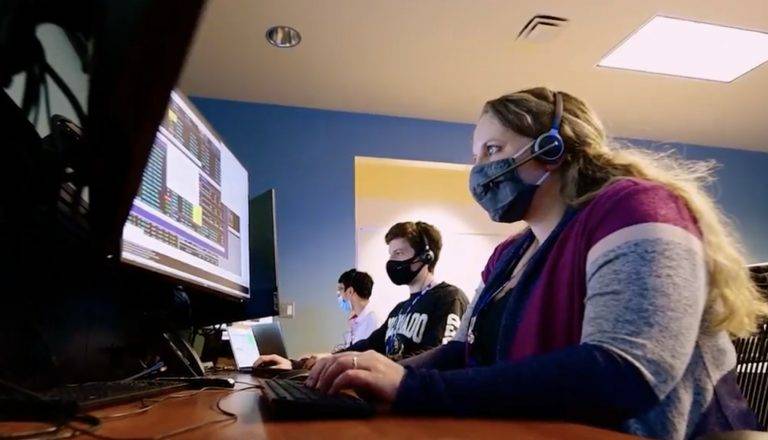
The summer prior to their junior year, students can enroll in an intensive, 12-week training program to join the team. They train side-by-side with certified LASP command controllers, learning all they can about executing flight operations, monitoring the health of spacecraft in flight, and troubleshooting issues in real time. Each student must complete a checklist of 300 mission-critical tasks on console and pass three written exams.
The paid positions don’t earn the undergrads course credit at the university, “but it gives them a definite leg up on their career goals,” Osborne said. “It’s a big commitment.”
Among those undergraduates now on console is Alexander Pichler, an aerospace engineering senior and the student lead for IXPE. He said there’s no substitute for learning in a practical environment like this one, which complements and informs every facet of his classroom education.
“It really has been an extraordinary opportunity,” said Pichler, now midway through his second year on the LASP team. “Now and then, I step back and think ‘I’m sending commands to a spacecraft that’s up there right now, helping to expand our understanding of the universe.’ It’s a truly horizon-widening experience.”
Davis, who graduated from CU-Boulder in 2020 with a degree in astronomy before joining the mission operations team, agrees.
“We’re doing brand new things that have never been done before, poking at big questions a lot of people shy away from: How is this possible? How can this exist?” she said. “It’s so exciting to be a part of it – helping to further a larger scientific conversation.”
Founded in 1948 on the campus of the University of Colorado-Boulder, LASP initially was known as the Upper Air Laboratory, where scientists studied the upper atmosphere using instruments, stabilizing technologies, and pointing platforms of their own design. When researchers spun off in 1956 to form Ball Aerospace & Technologies Corporation in Boulder, the university expanded its own program and renamed the facility.
Since then, LASP has sent an instrument to every planet in the solar system and beyond, contributing imaging and sensing data to a variety of high-profile NASA missions, including Galileo, Mariner, Viking, and LADEE. LADEE, flown in 2013 and 2014, helped NASA better understand electrostatically charged dust on the Moon – a crucial need for Artemis-era human exploration of the lunar surface. The LASP team also led mission operations for NASA’s Kepler spacecraft – which identified more than 2,500 verified planets orbiting distant stars from 2009 to 2018.
And the work continues. LASP will participate in the upcoming Near-Earth Object Surveyor mission to spot and track large asteroids and comets that could pose a risk to Earth – and Libera, tracking climate change by documenting energy dispersal from Earth’s atmosphere. Both missions are scheduled to launch later in this decade.
Managed by Marshall, IXPE is a collaborative effort with LASP; Ball Aerospace; the Italian Space Agency; McGill University in Montreal; Massachusetts Institute of Technology in Cambridge, Massachusetts; Roma Tre University in Rome; Stanford University in Stanford, California; and OHB Italia in Milan, Italy.
Smith, a Manufacturing Technical Solutions employee, supports Marshall’s Office of Strategic Analysis & Communications.
Astronomers Dig Out Buried Black Holes with NASA’s Chandra
Hundreds of black holes previously hidden, or buried, have been found using NASA’s Chandra X-ray Observatory. This result helps give astronomers a more accurate census of black holes in the universe.
The black holes in this new study are the supermassive variety that contain millions or even billions of times the mass of the Sun. While astronomers think that almost all large galaxies harbor giant black holes in their centers, only some of the black holes will be actively pulling in material that produces radiation, and some will be buried underneath dust and gas.
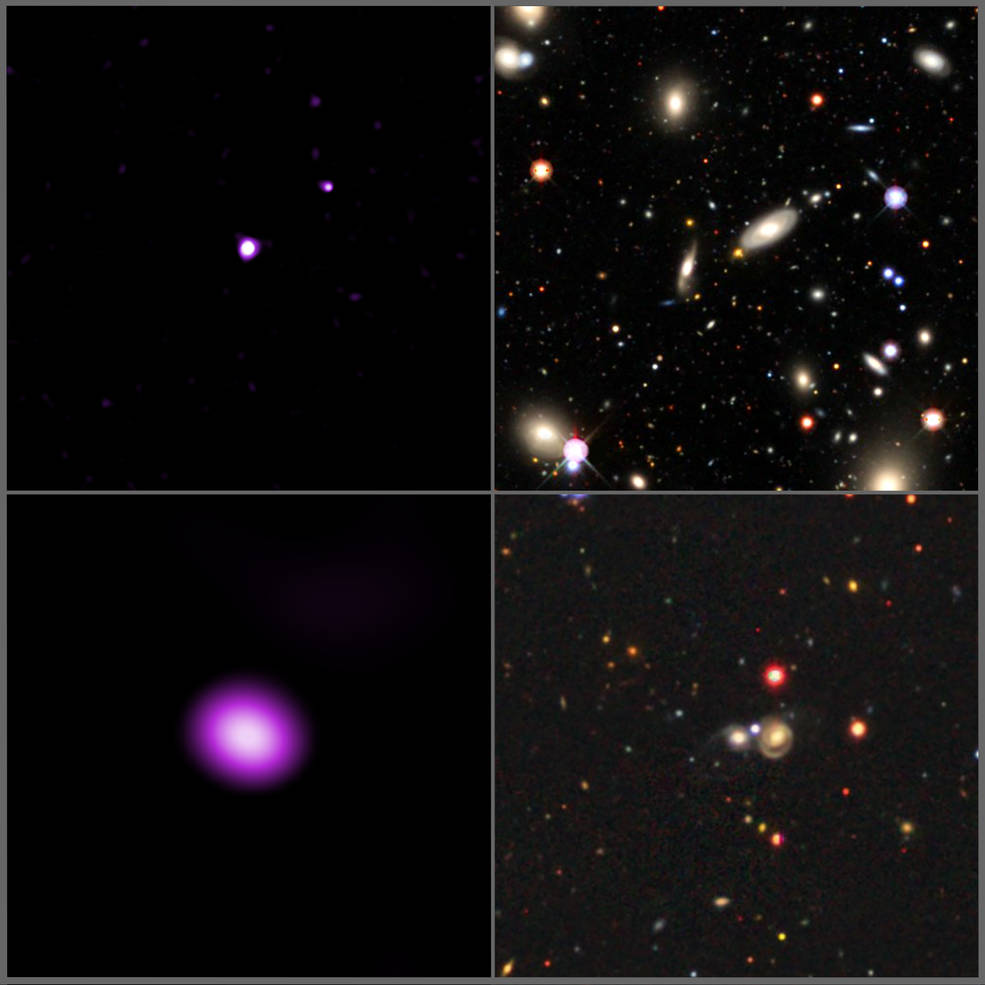
By combining data from the Chandra Source Catalog – a public repository including hundreds of thousands of X-ray sources detected by the observatory over its first 15 years – and optical data from the Sloan Digital Sky Survey (SDSS), a team of astronomers was able to identify hundreds of black holes that had previously been hidden. They are in galaxies not previously identified to contain quasars, extremely bright objects with rapidly growing supermassive black holes.
“Astronomers have already identified huge numbers of black holes, but many remain elusive,” said Dong-Woo Kim of the Center for Astrophysics | Harvard & Smithsonian, who led the study. “Our research has uncovered a missing population and helped us understand how they are behaving.”
For about 40 years scientists have known about galaxies that look normal in optical light – with light from stars and gas but not the distinctive optical signatures of a quasar – but shine brightly in X-rays. They refer to these objects as “X-ray bright optically normal galaxies” or “XBONGs.”
By systematically combing through the deep Chandra Source Catalog and comparing to SDSS optical data, the researchers identified 817 XBONG candidates, more than ten times the number known before Chandra was in operation. Chandra’s sharp images, matching the quality of those from SDSS, and the large amount of data in the Chandra Source Catalog made it possible to detect this many XBONG candidates. Further study revealed that about half of these XBONGs represent a population of previously hidden black holes.
“These results show how powerful it is to compare X-ray and optical data mines,” said co-author Amanda Malnati, an undergraduate student at Smith College in Northampton, Massachusetts. “The Chandra Source Catalog is a growing treasure that will help astronomers make discoveries for years to come.”
X-rays are particularly useful to search for rapidly growing black holes because material swirling around them is superheated to millions of degrees and glows strongly in X-ray wavelengths. A thick cocoon of gas and dust surrounding a black hole will block most or all the light at optical wavelengths. X-rays, however, pass through the cocoon much more easily to be detected by Chandra.
After studying the amount of X-rays detected at different energies for each source, the team concluded that about half the XBONG candidates involve X-ray sources that are buried under thick gas because relatively small amounts of low- energy X-rays were detected. Such X-rays are blocked more easily by layers of surrounding gas than higher- energy ones.
These X-ray sources are so bright that almost all of them must be from material surrounding rapidly growing supermassive black holes. Data from NASA’s Wide-Field Infrared Survey Explorer provides additional evidence that about half of the XBONGs are buried, growing supermassive black holes. These black holes range in distances between 550 million and 7.8 billion light-years from Earth.
“It’s not every day that you can say you discovered a black hole,” said co-author Alyssa Cassity, a graduate student at the University of British Columbia, “so, it’s very exciting to realize that we have discovered hundreds of them.”
The explanation for the XBONGs that are not buried underneath thick gas is less clear. About 100 of the X-ray sources may not be single points of X-rays sources, but instead appear spread out. Some of these may be galaxies in previously unidentified groups or clusters of galaxies, which are known to contain large quantities of hot, X-ray emitting gas. No more than about 20% of the XBONGs can be categorized this way. The remaining 30% may contain some supermassive black holes located in galaxies where the optical signals from the supermassive black holes are diluted by relatively bright light from stars. Scientists will need additional research to sort out the true nature of these XBONGs.
Dong-Woo Kim presented these results at the 241st meeting of the American Astronomical Society in Seattle.
NASA’s Marshall Space Flight Center manages the Chandra program. The Smithsonian Astrophysical Observatory’s Chandra X-ray Center controls science operations from Cambridge, Massachusetts, and flight operations from Burlington, Massachusetts.
Webb Uncovers Star Formation in Cluster’s Dusty Ribbons
NGC 346, one of the most dynamic star-forming regions in nearby galaxies, is full of mystery. Now, it is less mysterious with new findings from NASA’s James Webb Space Telescope.
NCG 346 is located in the Small Magellanic Cloud (SMC), a dwarf galaxy close to our Milky Way. The SMC contains lower concentrations of elements heavier than hydrogen or helium, which astronomers call metals, compared to the Milky Way. Since dust grains in space are composed mostly of metals, scientists expected there would be low amounts of dust, and that it would be hard to detect. New data from Webb reveals the opposite.
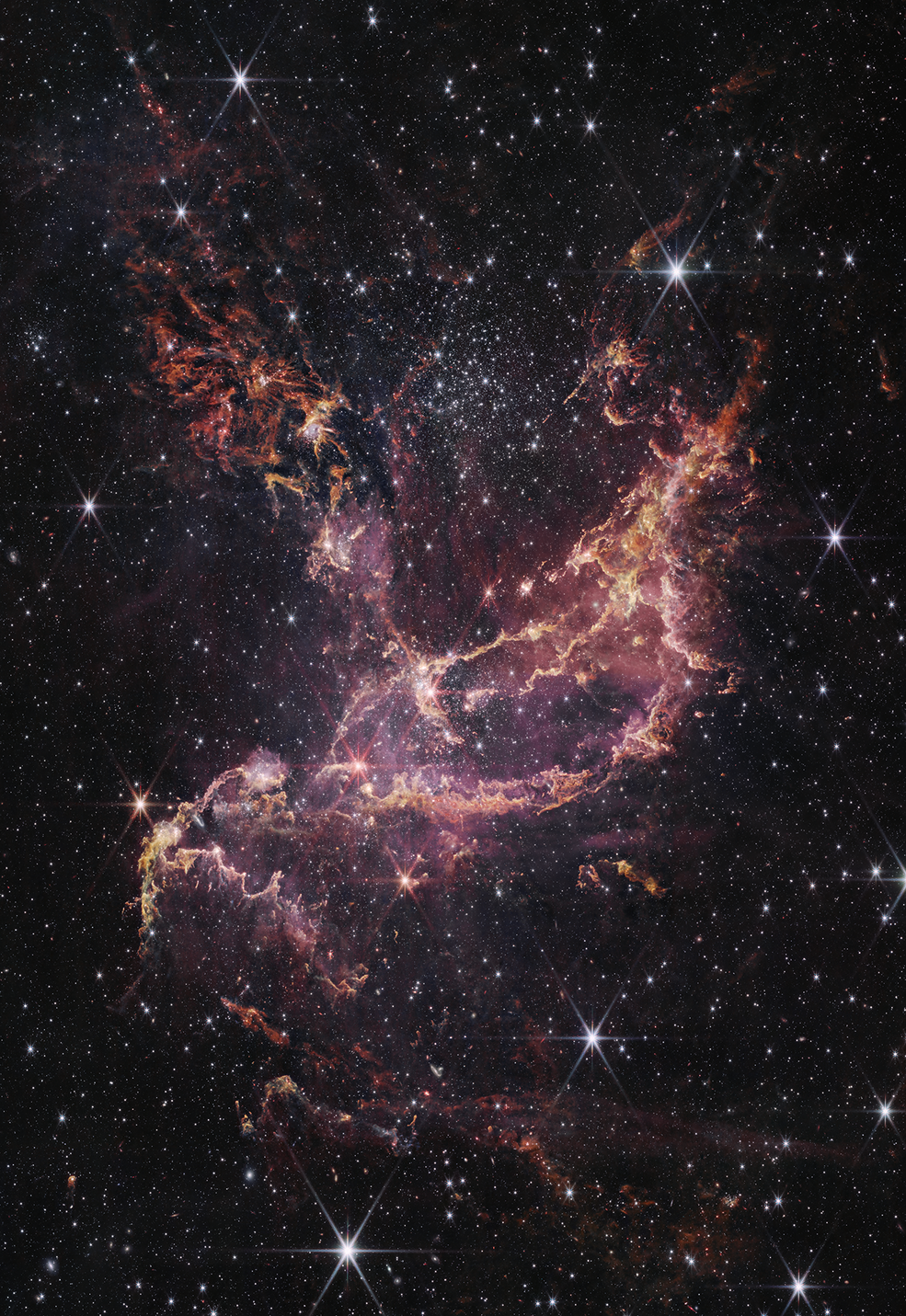
Astronomers probed this region because the conditions and amounts of metals within the SMC resemble those seen in galaxies billions of years ago, during an era in the universe known as “cosmic noon,” when star formation was at its peak. Some 2 to 3 billion years after the big bang, galaxies were forming stars at a furious rate. The fireworks of star formation happening then still shape the galaxies we see around us today.
“A galaxy during cosmic noon wouldn’t have one NGC 346 like the Small Magellanic Cloud does; it would have thousands” of star-forming regions like this one, said Margaret Meixner, an astronomer at the Universities Space Research Association and principal investigator of the research team. “But even if NGC 346 is now the one and only massive cluster furiously forming stars in its galaxy, it offers us a great opportunity to probe conditions that were in place at cosmic noon.”
By observing protostars still in the process of forming, researchers can learn if the star formation process in the SMC is different from what we observe in our own Milky Way. Previous infrared studies of NGC 346 have focused on protostars heavier than about 5 to 8 times the mass of our Sun. “With Webb, we can probe down to lighter-weight protostars, as small as one tenth of our Sun, to see if their formation process is affected by the lower metal content,” said Olivia Jones of the United Kingdom Astronomy Technology Centre, Royal Observatory Edinburgh, a co-investigator on the program.
As stars form, they gather gas and dust, which can look like ribbons in Webb imagery, from the surrounding molecular cloud. The material collects into an accretion disk that feeds the central protostar. Astronomers have detected gas around protostars within NGC 346, but Webb’s near-infrared observations mark the first time they have also detected dust in these disks.
“We’re seeing the building blocks, not only of stars, but also potentially of planets,” said Guido De Marchi of the European Space Agency, a co-investigator on the research team. “And since the Small Magellanic Cloud has a similar environment to galaxies during cosmic noon, it’s possible that rocky planets could have formed earlier in the universe than we might have thought.”
The team also has spectroscopic observations from Webb’s NIRSpec instrument that they are continuing to analyze. These data are expected to provide new insights into the material accreting onto individual protostars, as well as the environment immediately surrounding the protostar.
These results were presented Jan. 11 at the 241st meeting of the American Astronomical Society. The observations were obtained as part of program 1227.
The James Webb Space Telescope is the world’s premier space science observatory. Webb will solve mysteries in our solar system, look beyond to distant worlds around other stars, and probe the mysterious structures and origins of our universe and our place in it. Webb is an international program led by NASA with its partners, ESA (European Space Agency) and the Canadian Space Agency. Several NASA centers contributed to the project, including the agency’s Marshall Space Flight Center. Read more about Marshall’s work for the mission here.
Lunar Flashlight Team Assessing Spacecraft’s Propulsion System
NASA’s Lunar Flashlight mission successfully launched on Dec. 11, 2022, to begin its four-month journey to the Moon, where the small satellite, or SmallSat, will test several new technologies with a goal of looking for hidden surface ice at the lunar South Pole. While the SmallSat is largely healthy and communicating with NASA’s Deep Space Network, the mission operations team has discovered that three of its four thrusters are underperforming.
The mission team, which first observed the reduced thrust three days after launch, is working to analyze the issue and provide possible solutions. During its cruise, Lunar Flashlight’s propulsion system has operated for short-duration pulses of up to a couple seconds at a time. Based on ground testing, the team thinks that the underperformance might be caused by obstructions in the fuel lines that may be limiting the propellant flow to the thrusters.
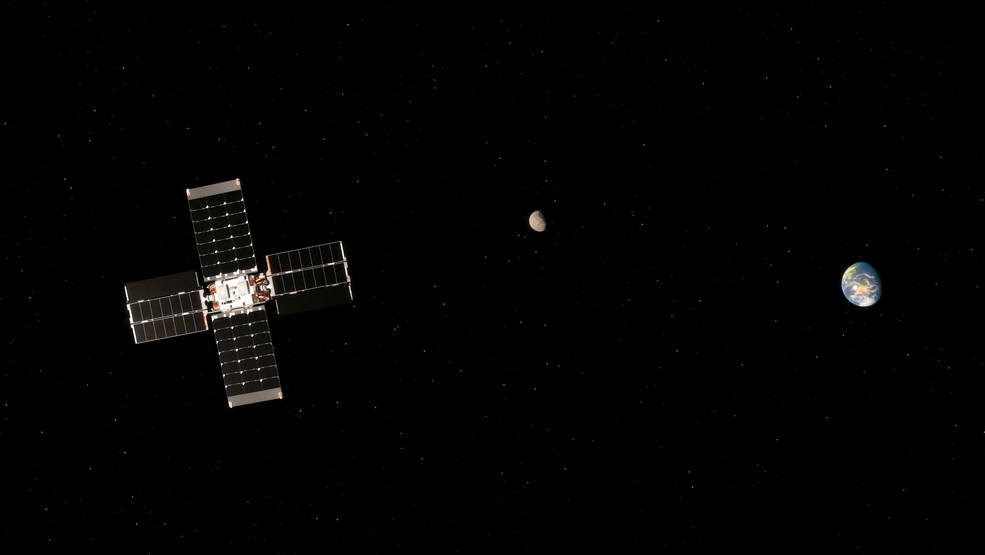
The team plans to soon operate the thrusters for much longer durations, hoping to clear out any potential thruster fuel line obstructions while carrying out trajectory correction maneuvers that will keep the SmallSat on course to reach its planned orbit around the Moon. In case the propulsion system can’t be restored to full performance, the mission team is drawing up alternative plans to accomplish those maneuvers using the propulsion system with its current reduced-thrust capability. Lunar Flashlight will need to perform daily trajectory correction maneuvers starting in early February to reach lunar orbit about four months from now.
Swooping low over the Moon’s surface, the briefcase-size SmallSat will use a new laser reflectometer built with four near-infrared lasers to shine a light into the permanently shadowed craters at the lunar South Pole to detect surface ice. To achieve this goal with the limited amount of propellent it’s built to carry, Lunar Flashlight will employ an energy-efficient near-rectilinear halo orbit, taking it within 9 miles of the lunar South Pole and 43,000 miles away at its farthest point.
Only one other spacecraft has employed this type of orbit: NASA’s Cislunar Autonomous Positioning System Technology Operations and Navigation Experiment (CAPSTONE) mission, which launched in June 2022 to a different near-rectilinear halo orbit, the same one that is planned for Gateway. CAPSTONE also experienced difficulties during its journey to the Moon, and some of the NASA teams who helped the SmallSat reach its planned orbit are lending their expertise to help resolve Lunar Flashlight’s thruster issues.
Managed by NASA’s Jet Propulsion Laboratory, Lunar Flashlight is the first interplanetary spacecraft to use a new kind of “green” propellant, called Advanced Spacecraft Energetic Non-Toxic (ASCENT), that is safer to transport and store than the commonly used propellants such as hydrazine. One of the mission’s primary goals is to demonstrate this technology for future use. The propellant was successfully tested with a previous NASA technology demonstration mission in Earth orbit.
Other systems on Lunar Flashlight are performing well, including the never-before-flown Sphinx flight computer, developed by JPL as a low-power, radiation-tolerant option for SmallSats. Also performing as designed, Lunar Flashlight’s upgraded Iris radio – which is used to communicate with the Deep Space Network – features a new precision navigation capability that future small spacecraft will use to rendezvous and land on other solar system bodies. Additional new and groundbreaking systems, such as the mission’s laser reflectometer, will be tested in the coming weeks before the mission enters lunar orbit.
Further updates on the status of the mission will be posted to NASA’s Small Satellite Missions blog.
Lunar Flashlight is managed for NASA by JPL. The SmallSat is operated by Georgia Tech, including graduate and undergraduate students. The Lunar Flashlight science team is led by NASA Goddard Space Flight Center, and includes team members from multiple institutions, including the University of California, Los Angeles; Johns Hopkins University Applied Physics Laboratory; and the University of Colorado.
The SmallSat’s propulsion system was developed by NASA’s Marshall Space Flight Center, with development and integration support from Georgia Tech. NASA’s Small Business Innovation Research program funded component development from small businesses including Plasma Processes Inc. (Rubicon) for thruster development, Flight Works for pump development, and Beehive Industries (formerly Volunteer Aerospace) for specific 3D-printed components. The Air Force Research Laboratory also contributed financially to the development of Lunar Flashlight’s propulsion system. Lunar Flashlight is funded by the Small Spacecraft Technology program within NASA’s Space Technology Mission Directorate.
Artemis III: NASA’s First Human Mission to the Lunar South Pole
Humans have always been drawn to explore, discover, and learn as much as we can about the world – and worlds – around us. This isn’t always easy, but it’s in our nature. For the benefit of all humanity, NASA and its partners will land the first woman and first person of color on the surface of the Moon with Artemis.
Following two Artemis test missions, Artemis III, currently planned for 2025, will mark humanity’s first return to the lunar surface in more than 50 years. NASA will make history by sending the first humans to explore the region near the lunar South Pole.
NASA’s Orion spacecraft will be the crew’s ride to and from Earth and into and out of lunar orbit. Orion is the only spacecraft capable of returning crews to Earth at lunar reentry velocities. On the successful Artemis I mission, Orion’s uniquely designed heat shield was recently tested under these extreme reentry conditions. Four astronauts will depart from Launch Pad 39B at Kennedy Space Center atop the Space Launch System (SLS), the only rocket powerful enough to send Orion, its crew, and their supplies to the Moon in a single launch. The crew will be selected from among the most diverse astronaut corps in history, each equipped with unique skills and intensively trained.
First the crew will launch to Earth orbit where they will perform systems checks and solar panel adjustments on Orion. Then, a powerful push from SLS’s interim cryogenic propulsion stage will help Orion perform a translunar injection maneuver, setting its course to the Moon.
For several days, the crew will travel toward the Moon and perform corrective engine burns to intercept the Moon’s gravitational field. At the right time and location, Orion will perform a series of two engine burns to place the spacecraft in a lunar Near-Rectilinear Halo Orbit (NRHO). From hundreds of potential orbits, NASA selected NRHO to achieve long-term Artemis goals. NRHO will provide near-constant communications with Earth and access to sites all over the Moon. Because it is gravitationally balanced between Earth and the Moon, this orbit will maximize fuel efficiency. On future missions, NASA and its partners will assemble the Gateway lunar space station in NRHO to serve as a hub for Artemis missions.
NASA has selected SpaceX to provide the human landing system that will transport Artemis III astronauts from Orion in lunar orbit to the surface of the Moon and back again. SpaceX plans to use a unique concept of operations to increase the overall efficiency of their lander. After a series of tests, SpaceX will fly at least one uncrewed demo mission that lands Starship on the lunar surface. When Starship has met all of NASA’s requirements and high standards for crew safety, it will be ready for its first Artemis mission.
Before the crew launch, SpaceX will launch a storage depot to Earth orbit. A series of reusable tankers will carry propellant to the storage depot to fuel the human landing system. The uncrewed Starship human landing system will then launch to Earth orbit and rendezvous with the storage depot to fill its tanks before executing a translunar injection engine burn and traveling approximately six days to NRHO where it will await the Artemis III crew.
When both spacecraft have arrived in NRHO, Orion will dock with the Starship human landing system in preparation for the first lunar surface expedition of the 21st century. Once the crew and their supplies are ready, two astronauts will board Starship and two will remain in Orion. Orion will undock and back away from Starship to remain in NRHO for roughly one orbit around the Moon, lasting about 6.5 days. This will match the length of the surface expedition, so as Orion completes its orbit, the two person surface crew will finish their work on the surface in time to launch back up to meet the spacecraft.
NASA has its sights set on locations around the South Pole for the Artemis era of human lunar exploration. Extreme, contrasting conditions make it a challenging location for Earthlings to land, live, and work, but the region’s unique characteristics hold promise for unprecedented deep space scientific discoveries. Using advanced technology including autonomous systems, the crew inside of Starship will land at a carefully selected site within a 100-meter radius.
After touchdown, the surface crew’s first task will be to ensure all systems are ready for their lunar surface stay. Then they will rest, eat, and recharge for the first full day of the expedition.
During their time on the Moon, the astronauts will do scientific work inside Starship and conduct a series of moonwalks, exiting Starship to explore the surface. The astronauts will don advanced spacesuits, exit through an airlock, and descend on Starship’s elevator. NASA has selected Axiom Space to provide the Artemis III surface suits and spacewalk systems. These suits will give the astronauts increased range of motion and flexibility to explore more of the landscape than on previous lunar missions.
During their moonwalks, the astronauts will take pictures and video, survey geology, retrieve samples, and collect other data to meet specific scientific objectives. The view from the lunar South Pole region will look very different from the photos taken on Apollo missions in the Moon’s equatorial region. The Sun will hover just above the horizon, casting long, dark shadows across the terrain, which the crew will explore using headlamps and navigational tools. The information and materials collected by Artemis III astronauts will increase our understanding of the mysterious South Pole region, the Moon, and our solar system.
Mission control teams on the ground will be in contact with the crew as they relay what they see, hear, and feel. Through mission coverage and the ability to send high quality images and video to the ground with advanced communication technology, they will be sharing a unique new human experience with the world.
When their surface expedition is complete, the two astronauts will lift off the surface of the Moon and head back to NRHO in Starship to reunite with their crewmates in Orion. After docking, the crew will spend up to five days in orbit, transferring samples between the vehicles and preparing for the journey back to Earth.
When they reach the optimal NRHO departure point, with all four astronauts back in Orion, they will undock and ignite Orion’s engines, slinging the spacecraft past the Moon, and allowing it to coast toward Earth. The crew will travel about 24,855 miles per hour during reentry into Earth’s atmosphere. Assisted by 11 parachutes, the spacecraft will splash down in the Pacific Ocean where it and the crew will be retrieved with support from the U.S. Coast Guard and U.S. Navy.
Artemis III will be one of the most complex undertakings of engineering and human ingenuity in the history of deep space exploration to date. The astronauts’ observations, samples, and data collected will expand our understanding of our solar system and home planet, while inspiring the next generation.
This mission will usher in a future in which humans consistently access the Moon, and human planetary exploration missions are within reach. Each Artemis mission will increase our knowledge, refine our operations, and prove our technology as we prepare for the first human mission to Mars.
50 States: Small Businesses
Small businesses across America are aiding NASA in building the systems to support Artemis missions to the Moon, Mars, and beyond. Watch to learn more about these companies. (NASA)


























